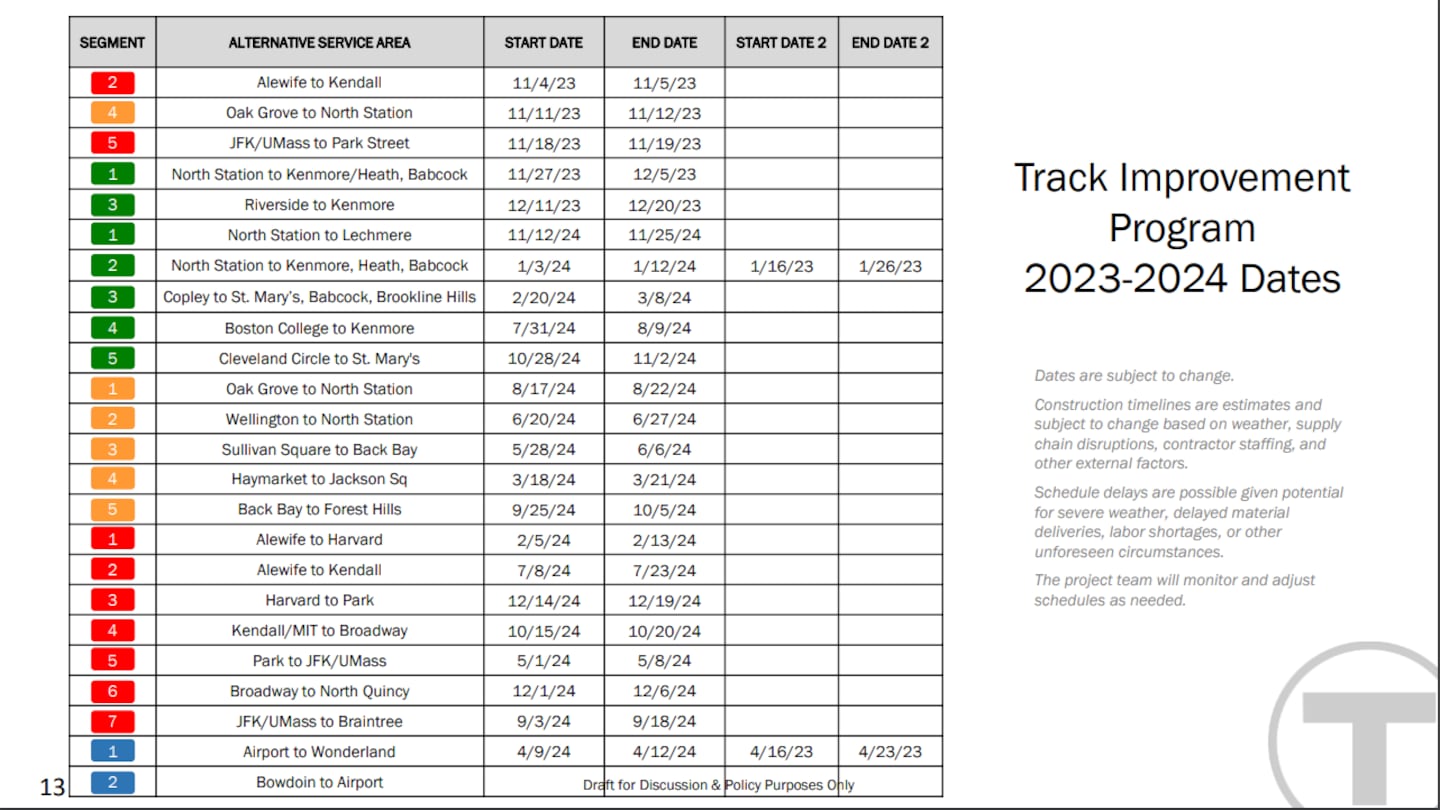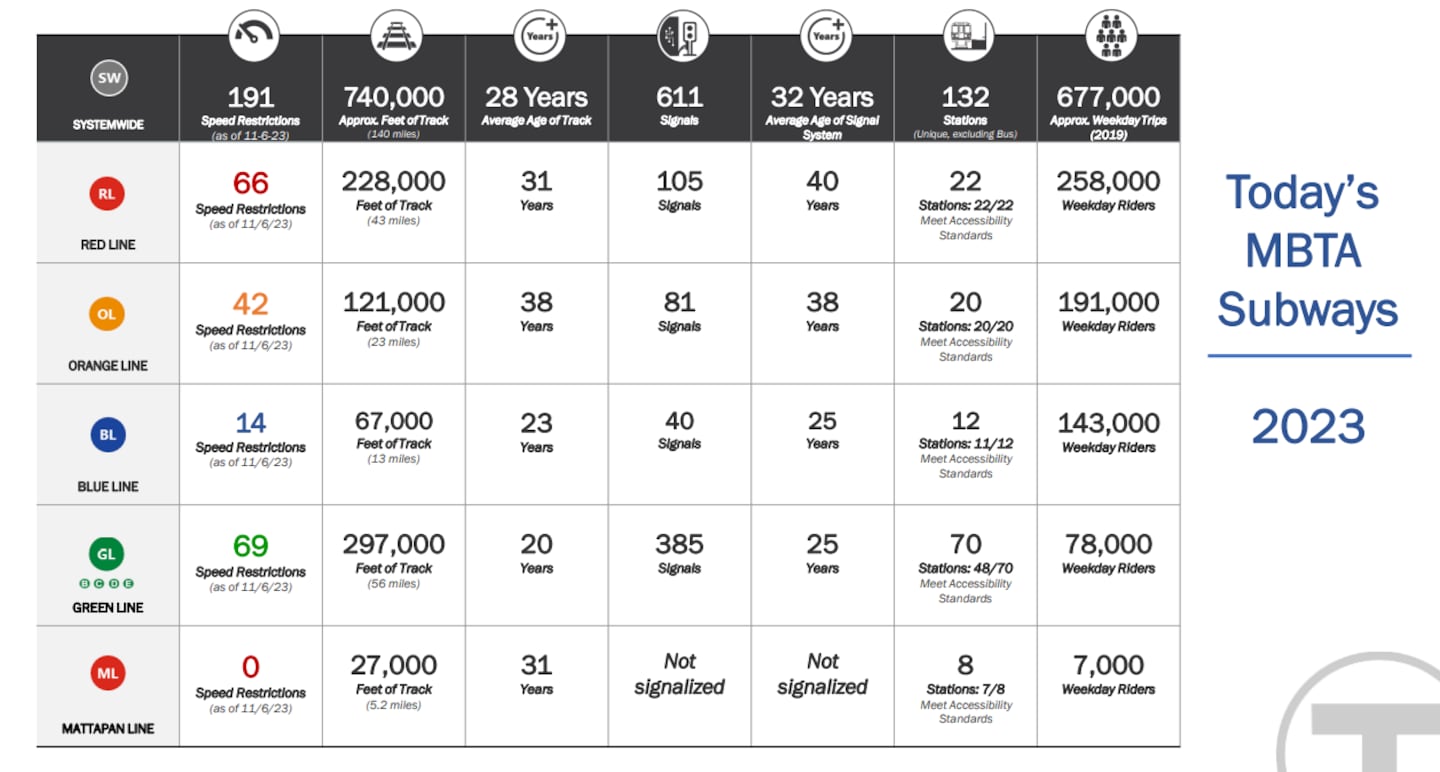BOSTON — In another new development with big implications for riders, the MBTA’s push to trade near-term headaches for long-term improvements will soon be put to the test on an unprecedented scale.
Reduced train speeds associated with safety concerns have plagued riders with sluggish travel for months, and MBTA officials on Thursday announced they now plan to shut down segments of all four subway lines in phases over the next 13 months, allowing for repairs they say will eliminate all “slow zones” by the end of 2024.
Repair work will replace rails, fix or replace deteriorated ties, install new ballast, improve signals and switches, and more, MBTA General Manager Phil Eng said. Free shuttle buses will replace subway service during closures.
The proposal will inflict widespread disruption on riders, with a portion of the core subway system scheduled to be closed on almost exactly half of the days between now and the end of next year.
With their new plan, MBTA officials are providing more advance notice than they have ahead of recent shutdowns, and for the first time are putting an estimated endpoint on the slow train service that has become the new norm and turned some riders away from the T.
Paraphrasing Lt. Gov. Kim Driscoll, Eng said the plan exchanges “short-term pain for long-term wins.”
“Not getting this work done has far longer-ranging impacts to the public that we serve,” Eng told the MBTA Board’s safety subcommittee while unveiling the schedule. “This is truly a pivotal time for the T as we’re looking to restore and repair years and years of disinvestment.”
The first closures will hit the Green Line. Subways will not run between North Station and Kenmore, Heath Street and Babcock Street from Nov. 27 to Dec. 5, nor will they operate along the entire D Branch from Riverside to Kenmore between Dec. 11 and Dec. 20.
For 2024, the plan lays out nearly 20 planned closures of individual pieces of the Green, Orange, Red and Blue Lines, ranging in duration between four days and 21 days. Eng said the sweeping proposal would eliminate all slow zones, which currently blanket about 23 percent of the system, plus tackle any new issues that emerge.
Altogether, MBTA modeling projects the work will slash a total of 86 minutes in delays that exist today because of infrastructure problems that prevent trains from safely operating at full speed.
“The intent is to, again, address those things that have been impacting the public today and address those things that, if we don’t get to, will impact them in future years,” Eng told reporters after the subcommittee meeting. “That will allow us now to come in and do that proper cyclical, preventive corrective maintenance on a regular basis, being able to respond more timely, and not allow us to get to the point where we’re trying to tackle hundreds of speed restrictions.”
The cost of the repair campaign was not available. Eng said the work will all be funded through existing budget sources, including money set aside for the MBTA to address problems identified in a Federal Transit Administration investigation and the agency’s five-year capital investment plan.
A “significant amount” of the work will be put out to bid, which Eng said might alter some of the specific closure dates.
Eng said Thursday that the T has reached a new agreement with private developer HYM Construction, whose demolition of the Government Center Garage has required multiple subway disruptions in recent months.
The company will finish work that normally impedes T service during a total of 20 days when the nearby portion of the Green Line is closed for infrastructure repairs. Once those diversions are complete, the remaining demolition work will continue without requiring any kind of MBTA coordination, Eng said.
“That’s a big win for both the Government Center garage demolition as well as us,” he said.
Widespread slow zones have become a debilitating way of life for most riders this year. An MBTA-hired consultant attributed the sudden escalation of the problem to poorly trained staff who were not “completely fulfilling the responsibilities” of track maintenance and safety standards, communications breakdowns and a lack of inspection documentation.
The MBTA has made a habit in recent years of shutting down large stretches of subway lines to accelerate repairs, most recently on the Red Line between JFK/UMass and Ashmont stations. That 16-day closure allowed officials to lift all slow zones in the area.
The new plan takes the effort to another level, charting a course months ahead of time. Rep. William Straus, who co-chairs the Legislature’s Transportation Committee, praised Eng’s approach with an apparent dig at former General Manager Steve Poftak and the Baker administration.
“The public should see that, with regard to the maintenance and taking-care-of-the-stuff obligation of the T, we now have the management capability that wasn’t there before,” Straus, who joined Eng at a press conference after the meeting, said Thursday.
Transit advocates and business groups praised the proposal as a step in the right direction, particularly because it gives the public more time to prepare for shutdowns and plan accordingly.
“The communication of a comprehensive, systemwide, year-long plan to address track issues is crucial and appreciated,” said Reggie Ramos, executive director of Transportation for Massachusetts. “We hope this signals a new level of transparency with the public for the MBTA especially as the work progresses. This allows impacted communities to plan their trips and activities ahead, and for municipalities to prepare for these shutdowns, ensuring riders’ lives are not disrupted greatly.”
A Better City President and CEO Kate Dineen said it “has the potential to restore rider trust, bolster our region’s economic competitiveness, and promote more climate-friendly commuting options.”
Still, advocacy group TransitMatters pointed out that the MBTA still has not outlined any plan to restore weekday Red, Orange and Blue Line service cuts implemented in June 2022, when federal investigators chided the T for overworking its dispatchers.
“While these diversions are necessary to clear the existing backlog of speed restrictions, track defects occur as a part of regular wear and tear. Going forward, the MBTA should ensure it has the capacity to handle new track defects with minimal disruption to regular service,” the group said. “If we want ridership to return to the pre-COVID levels, the T must improve speed restrictions and service levels as quickly as possible and run regular service as often as possible. Riders can learn to rely on the MBTA again, and we look forward to them doing so.”
MBTA: Plan to repair tracks, lift speed restrictions would deploy closures across 4 subway lines by Frank James on Scribd
This is a developing story. Check back for updates as more information becomes available.
Download the FREE Boston 25 News app for breaking news alerts.
Follow Boston 25 News on Facebook and Twitter. | Watch Boston 25 News NOW
©2023 Cox Media Group











